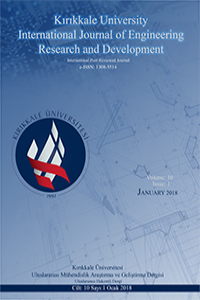2B Video ve Derinlik Haritası Temelli 3B Videolarda Yapısal Karmaşıklık Tabanlı Video Kalite Değerlendirmesi
Abstract
Günümüz teknolojilerindeki gelişmeler, yüksek
bant genişliğine sahip haberleşme kanallarının varlığı ve büyük video servis
sağlayıcılarının tüketici piyasasına girmesi 3 Boyutlu (3B) video
teknolojilerinin hızlı gelişim göstermesine neden olmuştur. 3B video
teknolojilerine geri bildirim oluşturabilmesi ve bu gelişime destek olması
dolayısı ile 3B Video Kalite Değerlendirmesi (VKD) günümüzde 3B video servis
sağlayıcıları için oldukça bir ihtiyaç haline gelmiştir. Literatürde zaman
alıcı ve maliyetli öznel testlerin yerini alabilecek, verimli, güvenilir ve
yaygın olarak kullanılan nesnel bir 3B VKD metriği bulunmadığından 3B VKD
yerine kullanılan 2 Boyutlu (2B) VKD metriklerinin çoğu Tam Referanslı (TR) ya
da Azaltılmış Referanslı (AR) metriklerdir. Bu metriklerin hem gerçek zamanlı
kalite ölçümü gerçekleştirmelerindeki eksiklikten hem de 3B videoların iletimi
için yüksek bant genişliğine ihtiyaç duyulmasından ötürü bu yöntemlerin verimli
olmadığı anlaşılmıştır. Dolayısıyla orijinal videodan ek bir bilgi gerekmeden
alıcı tarafta sadece sıkıştırılmış 3B videoyu kullanarak değerlendirme yapan
referanssız bir 3B VKD metriğinin kullanılması elzem olmuştur. Bu çalışmada,
IGS ile oldukça bağlantılı olan, 3B videolardaki objelerin kenar bilgileri
kullanılarak oluşturulan Yapısal Karmaşıklık (YK) temelli bir Referanssız 3B
VKD metriği geliştirilmiştir. Geliştirilen bu metrik kullanılarak elde edilen
verimli sonuçlar metriğin 3B video servislerinin geliştirilmesine büyük katkı
sağlayabileceğini göstermiştir.
References
- D.V.S.X. De Silva, G. Nur, E. Ekmekcioglu, and A. Kondoz, “QoE of 3D Media Delivery Systems,” Media Networks: Architectures, Applications, and Standards, CRC Press Taylor and Francis Group, May 2012.
- G. Nur Yilmaz, “A Depth Perception Evaluation Metric for Immersive 3D Video Services,” 3DTV-Conference: The True Vision - Capture, Transmission and Display of 3D Video, 7-9 June 2017.
- G. Nur Yilmaz, “A No Reference Depth Perception Assessment Metric for 3D Video,” Multimedia Tools and Applications, vol. 74, pp. 6937–6950, Sep. 2015. JSVM 9.13.1. CVS Server [Online]. Available Telnet: garcon.ient.rwth aachen.de:/cvs/jvt
- Gilbarg, D.; Trudinger, N. , Elliptic Partial Differential Equations of Second Order, Springer, ISBN 978-3-540-41160-4, 2001.
- Maria G.Martini, Chaminda T.E.R. Hewage, BarbaraVillarini, “Image Quality Assessment based on Edge Preservation”, Signal PRocessing: Image Communication, vol. 27, pp.875-882, September 2012.
- Maria G.Martini, Chaminda T.E.R. Hewage, BarbaraVillarini, Image quality assessment based on edge preservation, Brajesh Patel, Neelam Patel, Motion Detection based on multi frame video under Surveillance System, International Journal of Emerging Technology and Advanced Engineering 2 (1), January 2012.
- Q. Huynh-Thu, P. Le Callet, and M. Barkowsky, “Video Quality Assessment: From 2D to 3D Challenges and Future Trends,” 17th IEEE International Conference on Image Processing, Hong Kong, 26-29 Sep. 2010.
- Wei Fu; Xiaodong Gu; Yuanyuan Wang, "Image Quality Assessment Using Edge and Contrast Similarity," IEEE International Joint Conference on Neural Networks, 1-8 June 2008.
Abstract
3-Dimensional (3D) video technologies present rapid
improvement due the development of today’s technologies, the presence of the
communication channels having high bandwidth capacities, and the entrance of
the powerful video service providers into the consumer electronics market. 3D
Video Quality Assessment (VQA) becomes a must for the 3D video service
providers via feedback it provides to the 3D video technologies and its support
to this improvement. There is currently lack of an efficient, reliable, and
commonly utilized objective 3D VQA metric that is preferable than the
time-consuming and costly subjective tests. The 2-Dimensional (2D) VQA metrics
used instead of the 3D VQA metrics to fulfill this lack are mostly Full
Reference (FR) metrics or Reduced Reference (RR) metrics. These metrics are
considered inefficient due to their insufficiency at online quality evaluation
and requirement of high bandwidth capacity during the 3D video transmission.
Therefore, there becomes a need for a No Reference (NR) 3D VQA metric that does
not require any information related to the original video but only uses the
compressed 3D video for the assessment. In this study, a NR 3D VQA metric which
is based on Structural Complexity (SC) formed using edge information of the
objects existing in a 3D video is developed. The efficient results obtained
using the proposed metric prove that tremendous support can be provided to
improve the 3D video services using the proposed metric.
References
- D.V.S.X. De Silva, G. Nur, E. Ekmekcioglu, and A. Kondoz, “QoE of 3D Media Delivery Systems,” Media Networks: Architectures, Applications, and Standards, CRC Press Taylor and Francis Group, May 2012.
- G. Nur Yilmaz, “A Depth Perception Evaluation Metric for Immersive 3D Video Services,” 3DTV-Conference: The True Vision - Capture, Transmission and Display of 3D Video, 7-9 June 2017.
- G. Nur Yilmaz, “A No Reference Depth Perception Assessment Metric for 3D Video,” Multimedia Tools and Applications, vol. 74, pp. 6937–6950, Sep. 2015. JSVM 9.13.1. CVS Server [Online]. Available Telnet: garcon.ient.rwth aachen.de:/cvs/jvt
- Gilbarg, D.; Trudinger, N. , Elliptic Partial Differential Equations of Second Order, Springer, ISBN 978-3-540-41160-4, 2001.
- Maria G.Martini, Chaminda T.E.R. Hewage, BarbaraVillarini, “Image Quality Assessment based on Edge Preservation”, Signal PRocessing: Image Communication, vol. 27, pp.875-882, September 2012.
- Maria G.Martini, Chaminda T.E.R. Hewage, BarbaraVillarini, Image quality assessment based on edge preservation, Brajesh Patel, Neelam Patel, Motion Detection based on multi frame video under Surveillance System, International Journal of Emerging Technology and Advanced Engineering 2 (1), January 2012.
- Q. Huynh-Thu, P. Le Callet, and M. Barkowsky, “Video Quality Assessment: From 2D to 3D Challenges and Future Trends,” 17th IEEE International Conference on Image Processing, Hong Kong, 26-29 Sep. 2010.
- Wei Fu; Xiaodong Gu; Yuanyuan Wang, "Image Quality Assessment Using Edge and Contrast Similarity," IEEE International Joint Conference on Neural Networks, 1-8 June 2008.
Details
| Primary Language | Turkish |
|---|---|
| Journal Section | Research Article |
| Authors | |
| Publication Date | January 29, 2017 |
| Submission Date | November 20, 2017 |
| Published in Issue | Year 2018 Volume: 10 Issue: 1 |
Kırıkkale University, Faculty of Engineering and Natural Science, 71450 Yahşihan / Kırıkkale, Türkiye.
ijerad@kku.edu.tr

